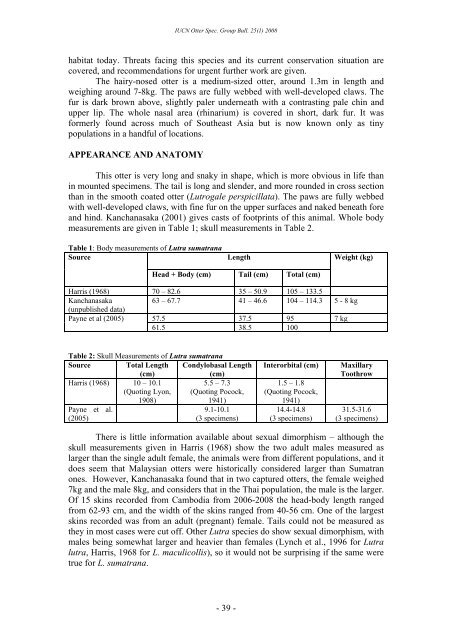N O T E F R O M T H E E D I T O R - Otter Specialist Group
N O T E F R O M T H E E D I T O R - Otter Specialist Group
N O T E F R O M T H E E D I T O R - Otter Specialist Group
- No tags were found...
Create successful ePaper yourself
Turn your PDF publications into a flip-book with our unique Google optimized e-Paper software.
IUCN <strong>Otter</strong> Spec. <strong>Group</strong> Bull. 25(1) 2008habitat today. Threats facing this species and its current conservation situation arecovered, and recommendations for urgent further work are given.The hairy-nosed otter is a medium-sized otter, around 1.3m in length andweighing around 7-8kg. The paws are fully webbed with well-developed claws. Thefur is dark brown above, slightly paler underneath with a contrasting pale chin andupper lip. The whole nasal area (rhinarium) is covered in short, dark fur. It wasformerly found across much of Southeast Asia but is now known only as tinypopulations in a handful of locations.APPEARANCE AND ANATOMYThis otter is very long and snaky in shape, which is more obvious in life thanin mounted specimens. The tail is long and slender, and more rounded in cross sectionthan in the smooth coated otter (Lutrogale perspicillata). The paws are fully webbedwith well-developed claws, with fine fur on the upper surfaces and naked beneath foreand hind. Kanchanasaka (2001) gives casts of footprints of this animal. Whole bodymeasurements are given in Table 1; skull measurements in Table 2.Table 1: Body measurements of Lutra sumatranaSourceLengthWeight (kg)Head + Body (cm) Tail (cm) Total (cm)Harris (1968) 70 – 82.6 35 – 50.9 105 – 133.5Kanchanasaka63 – 67.7 41 – 46.6 104 – 114.3 5 - 8 kg(unpublished data)Payne et al (2005) 57.5 37.5 95 7 kg61.5 38.5 100Table 2: Skull Measurements of Lutra sumatranaSource Total Length(cm)Condylobasal Length(cm)Harris (1968) 10 – 10.15.5 – 7.3(Quoting Lyon, (Quoting Pocock,1908)1941)Payne et al.(2005)9.1-10.1(3 specimens)Interorbital (cm)1.5 – 1.8(Quoting Pocock,1941)14.4-14.8(3 specimens)MaxillaryToothrow31.5-31.6(3 specimens)There is little information available about sexual dimorphism – although theskull measurements given in Harris (1968) show the two adult males measured aslarger than the single adult female, the animals were from different populations, and itdoes seem that Malaysian otters were historically considered larger than Sumatranones. However, Kanchanasaka found that in two captured otters, the female weighed7kg and the male 8kg, and considers that in the Thai population, the male is the larger.Of 15 skins recorded from Cambodia from 2006-2008 the head-body length rangedfrom 62-93 cm, and the width of the skins ranged from 40-56 cm. One of the largestskins recorded was from an adult (pregnant) female. Tails could not be measured asthey in most cases were cut off. Other Lutra species do show sexual dimorphism, withmales being somewhat larger and heavier than females (Lynch et al., 1996 for Lutralutra, Harris, 1968 for L. maculicollis), so it would not be surprising if the same weretrue for L. sumatrana.- 39 -
















